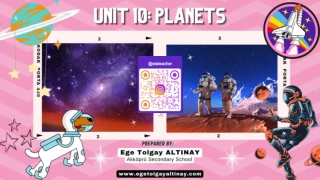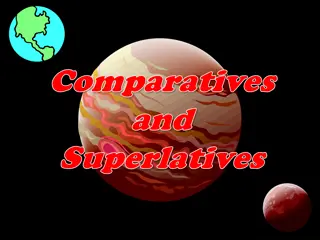Exploring the Mysteries of Neptune
Neptune, the eighth planet in our solar system, is a fascinating icy giant with extreme weather conditions. Named after the Roman god of the sea, Neptune's deep blue hue and cold temperatures make it an intriguing celestial body. With its strong gravity and icy composition, Neptune presents unique challenges for any potential human explorers. Discover more about this distant planet's characteristics and history, including its numerous moons and rings.
Download Presentation

Please find below an Image/Link to download the presentation.
The content on the website is provided AS IS for your information and personal use only. It may not be sold, licensed, or shared on other websites without obtaining consent from the author. Download presentation by click this link. If you encounter any issues during the download, it is possible that the publisher has removed the file from their server.
E N D
Presentation Transcript
Our report is on Neptune. Neptunes name comes from the Roman god of the sea. The symbol is a fishing spear or trident. It obviously gets its name from its bright blue colour.
It is the eighth planet in the solar system. Its the fourth largest, Saturn being the biggest. It s is 30,775 miles long and 2,790,000,000 miles from the sun. It has eight moons, three larger and five smaller. It has four faint rings in clumps.
Neptunes gravity is 1.19 times the gravity on Earth. Gravity is the force pulling us down. If there was no gravity we would float. Therefore Neptune has a lot of gravity.
The temperature on Neptune is 48k which is -214 degrees Celsius. Therefore you would freeze to death. The weather conditions are cold windy and unsuitable for human life. It is unbearable! Did you know Neptune is classified as the Ice giant planet!
It rotates on its axis at 30 to the plain of its orbit around the Sun. Each day on Neptune is 19.2 hours on Earth. Its seasons last for over 40 years. Imagine how long your summer holidays would be!
Neptune is mostly made of hydrogen. Its made of helium too. It is made of other chemicals which can form ice in the solar system s temperature. It is extremely cold....Brrrrrrr!
A human on this planet would die of the freezing temperatures on of -200 c! Imagine how cold Winter would be!
NASAs voyager two was the first thing ever to land on it, in the September of from Earth. Before this voyage nothing was really known about the blue planet.
DID YOU KNOW..? Neptune has the strongest winds in the solar system... Imagine a hurricane with winds that go up to 2,100 km/hour. On Earth a force 12 hurricane is approximately 118 km/hour! Neptune s colour is caused by a chemical called methane on the surface of the Gas giant.
DID YOU KNOW?... Neptune has eight moons three big and five smaller. Neptune s rings get their names from the founders. It takes approximately 165 years for it to orbit the Sun. Neptune hasn't yet completed a full orbit since it was first discovered in 1846.
DISCOVERY OF NEPTUNE.. These three men discovered Neptune: J.C. Adams J.G. Galle Le Verrier
REFERENCES...... Wikipedia, Enchanted learning, Google search, Smart Notebook and astronomy books from our class library.
This is our project on Neptune! We learned a lot and we hope you have too! Now we have a short diagram on the solar system to make it easier to understand. And a few questions! Have fun....



![[PDF] DOWNLOAD READ Diagnosis Solving the Most Baffling Medical Mysterie](/thumb/9855/pdf-download-read-diagnosis-solving-the-most-baffling-medical-mysterie.jpg)

![[PDF⚡READ❤ONLINE] Neptune: The Planet, Rings, and Satellites](/thumb/21522/pdf-read-online-neptune-the-planet-rings-and-satellites.jpg)

















